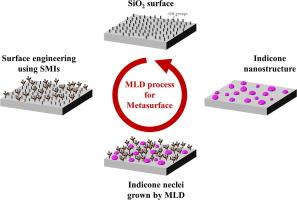当前位置:
X-MOL 学术
›
Appl. Surf. Sci.
›
论文详情
Our official English website, www.x-mol.net, welcomes your
feedback! (Note: you will need to create a separate account there.)
Advanced indicone Nanostructuring: Surface engineering with small molecule inhibitors through molecular layer deposition
Applied Surface Science ( IF 6.3 ) Pub Date : 2024-11-17 , DOI: 10.1016/j.apsusc.2024.161834 Hae Lin Yang, Gi-Beom Park, GeonHo Baek, Jinhong Park, Kwang Heo, Bo Keun Park, Jung-Hoon Lee, Jinho Ahn, Jin-Seong Park
Applied Surface Science ( IF 6.3 ) Pub Date : 2024-11-17 , DOI: 10.1016/j.apsusc.2024.161834 Hae Lin Yang, Gi-Beom Park, GeonHo Baek, Jinhong Park, Kwang Heo, Bo Keun Park, Jung-Hoon Lee, Jinho Ahn, Jin-Seong Park

|
Our study introduces a novel approach to forming transparent nanostructured surfaces using novel surface engineering technique of indicone, a promising organic–inorganic hybrid material with high potential for next-generation optical applications. By combining an indium metal–organic precursor with phloroglucinol in the MLD process, we achieved indicone layers that exhibit approximately 70% transmittance in the visible spectrum and a refractive index of 1.7–2.0, making them ideal for advanced metasurface application. To gain effective control over surface nucleation and enhance nanostructural definition, we employed N,N-Dimethyltrimethylsilylamine (DMA-TMS) as a small molecule inhibitor (SMI). The inhibitor’s chemical adaptability, reduced steric hindrance, and high surface coverage enabled the controlled growth of indicone nanostructures after 16 MLD cycles, achieving a transparent surface with finely tuned morphology. Also, Atomic Force Microscopy (AFM) provided direct visualization of the nanoscale changes in z-height and morphology, highlighting the successful control achieved through DMA-TMS regulation. Surfaces without SMI treatment showed rapid nucleation and smoothness, emphasizing the impact of our approach in forming nanoscale features. These findings underscore the effectiveness of our surface engineering technique for creating transparent, nanostructured indicone surfaces, with AFM analysis playing a pivotal role in verifying morphological control. This method advances nanofabrication techniques, supporting the integration of indicone in a variety of next-generation optical applications.
中文翻译:

先进的籟酮纳米结构:通过分子层沉积使用小分子抑制剂进行表面工程
我们的研究介绍了一种使用新型 indicone 表面工程技术形成透明纳米结构表面的新方法,indicone 是一种很有前途的有机-无机杂化材料,具有在下一代光学应用中的巨大潜力。通过在 MLD 工艺中将铟金属有机前驱体与间苯三酚相结合,我们实现了在可见光谱中表现出约 70% 透射率和 1.7-2.0 折射率的籼酮层,使其成为高级超表面应用的理想选择。为了获得对表面成核的有效控制并增强纳米结构定义,我们采用 N,N-二甲基三甲基硅胺 (DMA-TMS) 作为小分子抑制剂 (SMI)。该抑制剂的化学适应性、降低的空间位阻和高表面覆盖率使籼酮纳米结构能够在 16 个 MLD 循环后受控生长,从而获得具有精细形态的透明表面。此外,原子力显微镜 (AFM) 提供了 z 高度和形态纳米级变化的直接可视化,突出了通过 DMA-TMS 调节实现的成功控制。未经 SMI 处理的表面显示出快速成核和光滑度,强调了我们的方法在形成纳米级特征方面的影响。这些发现强调了我们的表面工程技术在创建透明、纳米结构的 indone 表面方面的有效性,AFM 分析在验证形态控制方面发挥着关键作用。该方法推进了纳米制造技术,支持将 indickone 集成到各种下一代光学应用中。
更新日期:2024-11-18
中文翻译:

先进的籟酮纳米结构:通过分子层沉积使用小分子抑制剂进行表面工程
我们的研究介绍了一种使用新型 indicone 表面工程技术形成透明纳米结构表面的新方法,indicone 是一种很有前途的有机-无机杂化材料,具有在下一代光学应用中的巨大潜力。通过在 MLD 工艺中将铟金属有机前驱体与间苯三酚相结合,我们实现了在可见光谱中表现出约 70% 透射率和 1.7-2.0 折射率的籼酮层,使其成为高级超表面应用的理想选择。为了获得对表面成核的有效控制并增强纳米结构定义,我们采用 N,N-二甲基三甲基硅胺 (DMA-TMS) 作为小分子抑制剂 (SMI)。该抑制剂的化学适应性、降低的空间位阻和高表面覆盖率使籼酮纳米结构能够在 16 个 MLD 循环后受控生长,从而获得具有精细形态的透明表面。此外,原子力显微镜 (AFM) 提供了 z 高度和形态纳米级变化的直接可视化,突出了通过 DMA-TMS 调节实现的成功控制。未经 SMI 处理的表面显示出快速成核和光滑度,强调了我们的方法在形成纳米级特征方面的影响。这些发现强调了我们的表面工程技术在创建透明、纳米结构的 indone 表面方面的有效性,AFM 分析在验证形态控制方面发挥着关键作用。该方法推进了纳米制造技术,支持将 indickone 集成到各种下一代光学应用中。


















































 京公网安备 11010802027423号
京公网安备 11010802027423号